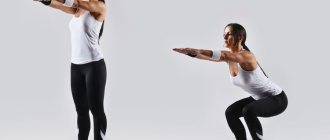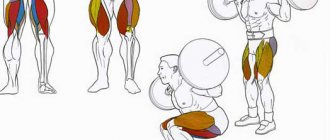Even at school, during physical education lessons, teachers teach children to squat, but not every teacher takes this exercise seriously, so as a person ages, he or she can come to the gym without having mastered the basics of physical training in childhood. It would seem that what could be done wrong here? After all, this ability to squat is inherent in man by nature. Let's look at the breathing technique when doing squats.
- Squat technique, how to squat correctly
- Video: Squat technique
- Breathing aspects: How should you breathe correctly when squatting?
- Breathing technique for barbell squats
- Useful tips on breathing techniques when squats
Correct breathing when squats
When performing any physical activity, in particular squats, you need to breathe properly.
The saturation of the body with oxygen, proper energy expenditure and the effectiveness of the workout as a whole depend on this. If during exercise a person breathes incorrectly, for example, too quickly or does not exhale deeply enough, then it becomes quite difficult for the body, there is an additional load on the heart and the entire circulatory system, and in addition, the effect of the training is not as high as expected.
Correct breathing - healthy heart
Many girls, when starting training, don’t even think about why they need to breathe properly during physical activity. Intense training puts a lot of stress on the body, so it needs additional oxygen. This will allow all the necessary substances to flow evenly into the muscles and internal organs.
When the lungs are suddenly filled with oxygen or exhaled in jerks, the load on the heart increases. Hypoxia begins, which leads to fainting.
When squats, your back should be straight, you cannot lean forward, otherwise your breathing will constantly become difficult.
Lack of oxygen in the blood can lead to dizziness and fainting
The benefits of proper breathing when squats
Every trainee, from a professional athlete to a person who exercises occasionally, needs to breathe properly.
During squats, you should pay particular attention to your breathing tactics, as this has a positive effect on:
- Achieving maximum physical results.
- Health safety.
- Normal muscle work.
If you inhale and exhale correctly, the risk of muscle strains is reduced by 30% - 35%.
- Saturation of all cells with oxygen.
- The work of the heart.
Improper breathing during squats puts extra strain on the heart and causes it to beat faster.
- Uniform distribution of nutrients throughout tissues and cells.
- Physical endurance.
Correctly done inhalations and exhalations increase physical endurance by 2.5 times.
Types of breathing
In physiology, breathing is divided into two types:
- Thoracic, in which there is a smooth expansion of the chest and raising of the ribs.
The chest appearance is typical during everyday life, when a person does not perform physical exercise, but performs ordinary activities at a calm and moderate pace.
- Abdominal, characteristic when a person trains or resorts to physical effort. During this type it is noted:
- changes in the chest, it becomes denser and larger in volume;
- inhalations - exhalations become more frequent and deeper;
- the diaphragm starts working.
How to breathe during classic squats?
In order to do the exercise as easily as possible, you need to breathe correctly.
When performing classic squats, a person is recommended to resort to the following technique:
- Stand up straight, completely relax for 2 - 3 seconds and exhale as deeply as possible.
- Lower yourself calmly and evenly, while taking a deep breath through your nose.
During the first squat, you need to make sure that your lips are closed.
- At the moment when the pelvis is level with the line of the knees, you need to exhale.
- The next entry must be made at the moment of raising the pelvis.
Breathing while squatting with a barbell
When performing exercises with a barbell, the load on all organs increases by 2–3 times, therefore, you need to monitor your breathing technique especially carefully.
If the trainee neglects the advice and takes incorrect inhalations and exhalations, this can lead to:
- ligament and muscle ruptures;
- enormous load on the heart;
- sudden darkening of the eyes;
- fainting;
- muscle pain;
- cramps.
For people who squat with a barbell, basic breathing rules have been developed, which consist of performing ten important steps:
- Before starting your workout, walk or stand quietly for 2–3 minutes so that your breathing and heart rate are completely normalized.
It is not recommended to move on to squats with a barbell immediately after performing other exercises, for example, push-ups or a short (long) distance race due to the increased load on the lungs and cardiovascular system.
- Take an extremely deep, but smooth inhale and exit, and then approach the bar.
- Take the barbell in your hands and throw it over your shoulders.
- Spread your legs as wide as possible, but at the same time make it comfortable to perform the exercise.
- Spoil your back.
- Take a deep breath.
- Go down to the intended limit, for example, to the knee line.
- Hold your breath for two seconds.
- While lifting the body, exhale smoothly, and it can be done through the nose or through the mouth, the main thing is that the teeth are interlocked.
- Stand up straight, and then make a sharp release of the remaining oxygen.
When exercising with a barbell, it is necessary to breathe correctly from the first squat, only in this case, throughout the entire workout, breathing will not be interrupted, and the load on the heart and muscles will be optimal.
Breathing during squats
First, let's look at squats without a barbell. Typically, bodyweight exercises are used as cardio to lose weight and maintain muscle tone. Therefore, first of all, it is necessary to perform an intense warm-up to prepare the lungs for the load and bring the heart rate to the aerobic zone. The breathing technique when warming up does not have strict recommendations; breathe as comfortably as possible.
After warming up, stand up straight and straighten your back. Inhale and squat at the same time. Exhale as you rise up. Proper breathing during fast squats without weight should not be deep. If you breathe deeply, you will soon lose your pace and feel short of breath. Therefore, take medium inhalations and exhalations.
There is no need to delay inhaling oxygen either in the lower phase of the movement or during the ascent.
Now let's look at squats with a barbell on the shoulders. Since these are strength exercises, you should warm up well before performing them.
In this case, pay attention not to preparing the pulse, but to warming up the muscles and joints of the legs. Do 2-3 sets of squats without weight, perform simple joint exercises
This will help prevent injury and enhance muscle response when lifting heavy weights.
After warming up, go to the racks and remove the bar from the supports. Inhale smoothly and lower yourself into a squat. Hold your breath midway through the movement. Once you get past the bottom point, climb up. Exhale after completing half the lifting amplitude. Such breathing during squats with a barbell increases intra-abdominal pressure, which increases the tone of the body muscles and helps lift heavy weights.
The technique of power squats with delayed oxygen consumption has its opponents. The main complaint is an increase in intra-abdominal pressure, which leads to overstrain of the cardiovascular system.
Yes, there really is such a risk. But this is precisely why squats with heavy equipment are contraindicated for athletes with serious pathologies of the heart and blood vessels.
When performing any physical activity, in particular squats, you need to breathe properly. The saturation of the body with oxygen, proper energy expenditure and the effectiveness of the workout as a whole depend on this.
If during exercise a person breathes incorrectly, for example, too quickly or does not exhale deeply enough, then it becomes quite difficult for the body, there is an additional load on the heart and the entire circulatory system, and in addition, the effect of the training is not as high as expected.
Breathing while resting between squats
When a person trains, special attention should be paid to breathing during rest.
Otherwise, the trainee:
- will not be able to fully recover between sets of squats;
- his heart rate will not have time to normalize;
- there will be additional stress on the lungs and vascular system;
- gets tired quickly;
- may lose consciousness during the next series of squats.
To prevent all negative consequences during rest, it is recommended:
- Inhale and exit exclusively through your nose.
- When inhaling, try to get as much oxygen as possible into the lungs.
- Exit should be done smoothly and until the chest is cleared of oxygen.
How to breathe when doing Bubnovsky squats?
Sergei Bubnovsky, who is the author of many books on physical culture, has developed certain recommendations for breathing techniques during squats.
In his opinion, it is effective for every person to adhere to the following rules:
- Keep your back and arms straight while doing squats.
- Stand facing the wall.
- Squat only while inhaling.
- When lifting the body, make a sharp and as deep as possible exit, while making a drawn-out sound “ha”
When performing any physical activity, in particular squats, it is important for a person to monitor his breathing. The degree of oxygen saturation of all cells and tissues, the functioning of the cardiovascular system, the load on the muscles, etc. depend on this. If the technique of inhalation and exhalation is not followed, there is a risk of losing consciousness, worsening heart function, and also physically not being able to withstand the entire workout to the end.
Blitz tips:
- do not forget to rest between sets of squats;
- before starting an exercise with a barbell, you need to make sure that your breathing has leveled out;
- If breathing is not restored even after 10-15 minutes after the end of the workout, even though the load was feasible, you should consult a doctor.
Breathing during squats: correct technique and useful tips
Squats are one of the best exercises for developing your lower body. With its help, you can both increase muscle mass and lose weight. It is due to its versatility and high efficiency that squats have gained high popularity.
Very often they discuss some technical issues regarding the correct execution, but how to breathe when doing squats is not discussed in detail. Meanwhile, this is one of the important points. For the normal functioning of all processes - gaining muscle mass or losing weight, the body requires oxygen.
Abdominal breathing is the best solution for squats.
And this applies to absolutely all exercises, in particular basic, multi-joint ones.
Proper breathing during squats is very important, since the body spends a lot of energy and requires oxygen, which promotes fat oxidation.
It’s worth noting right away that training in stuffy rooms is a bad idea. The load on the heart increases, and when performing exercises in conditions of lack of oxygen, you can lose consciousness.
Execution technique
Standing in the starting position, start moving downwards - while inhaling, when going up - exhale. How to breathe correctly when squatting, technique, the role of breathing in performing the exercise - all this affects the effectiveness of the entire workout.
The squat is performed to a position of 90 degrees between the thigh and shin. This technique is used in a fitness format. Weightlifters and bodybuilders use a technique in which this 90-degree angle must be passed. That is, the squat is performed lower. You can use any option. It is believed that exercises are most effective when the athlete squats below parallel (thigh parallel to the floor). When the required position is reached, the upward movement begins. In this case, the question of how to breathe correctly when squatting should no longer arise.
Throughout the entire movement, the chest is open, the shoulders are straightened, the back is straight, the gaze is directed forward or upward.
If the squat is performed with a barbell, then before you start it, you need to approach the barbell, determine its middle, choose the optimal position for your hands, and fix them on the bar. After this, you should place both legs strictly under the barbell (without a spreader), and fix the apparatus on the upper back (namely on the trapezius muscles). Only after this can you remove the barbell from the racks, take a few steps back, straighten up and start doing the exercise.
What are the benefits of proper breathing?
All exercise, be it strength or aerobic, must be performed correctly. And this includes not only the technique of execution, but also the ability to breathe correctly. Breathing while squatting will allow you to get maximum results from the exercise. In addition, it has a positive effect on health.
Improper breathing during exercise can be harmful. For example, if you hold your breath during a basic exercise, this will lead to an increase in pressure. As a result, headache and inability to continue training.
Thus, it is better to know how to breathe properly when squatting and take it as seriously as possible. This will be especially true when working with large weights:
- Correctly done inhalations and exhalations will make it easier to overcome various difficult moments.
- This will not only be safe for health, but will also make it possible to make your workout more productive by increasing the number of approaches and repetitions.
When working with heavy weights, you need to not only inhale and exhale, but do it at the right moment. For example, maximum effort occurs during exhalation. At this moment, oxygen disperses throughout the body, entering muscle tissue, the brain, carrying the necessary substances and hormones to the organs.
Do you want to improve your figure and health, without harming your spine and joints? Get my free resources on smart fitness at the gym or at home and learn how to exercise the right way!
They are suitable for both beginners and advanced fitness fans.











